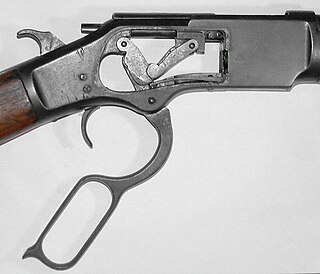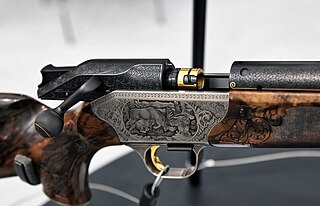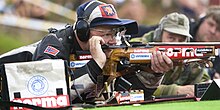
Bolt-action is a type of manual firearm action that is operated by directly manipulating the bolt via a bolt handle, which is most commonly placed on the right-hand side of the firearm.

In firearms terminology, an action is the functional mechanism of a breech-loading firearm that handles the ammunition cartridges, or the method by which that mechanism works. Actions are technically not present on muzzleloaders, as all those are single-shot firearms with a closed off breech with the powder and projectile manually loaded from the muzzle. Instead, the muzzleloader ignition mechanism is referred to as the lock.
A semi-automatic firearm, also called a self-loading or autoloading firearm, is a repeating firearm whose action mechanism automatically loads a following round of cartridge into the chamber and prepares it for subsequent firing, but requires the shooter to manually actuate the trigger in order to discharge each shot. Typically, this involves the weapon's action utilizing the excess energy released during the preceding shot to unlock and move the bolt, extracting and ejecting the spent cartridge case from the chamber, re-cocking the firing mechanism, and loading a new cartridge into the firing chamber, all without input from the user. To fire again, however, the user must actively release the trigger, allow it to "reset", before pulling the trigger again to fire off the next round. As a result, each trigger pull only discharges a single round from a semi-automatic weapon, as opposed to a fully automatic weapon, which will shoot continuously as long as the ammunition is replete and the trigger is kept depressed.

A lever action is a type of action for repeating firearms that uses a manually operated cocking handle located around the trigger guard area that pivots forward to move the bolt via internal linkages, which will feed and extract cartridges into and out of the chamber, and cock the firing pin mechanism. This contrasts to other type of repeating actions such as the bolt-action, pump-action, semi-automatic, fully automatic, and/or burst mode actions. A firearm using this operating mechanism is colloquially referred to as a levergun.
Pump action is a type of manual firearm action that is operated by moving a sliding handguard on the gun's forestock. When shooting, the sliding forend is pulled rearward to eject any expended cartridge and typically to cock the hammer or striker, and then pushed forward to load a new cartridge into the chamber. Most pump-action firearms use an integral tubular magazine, although some do use detachable box magazines. Pump-action firearms are typically associated with shotguns, although it has been used in rifles, grenade launchers, as well as other types of firearms. A firearm using this operating mechanism is colloquially referred to as a pumpgun

A breechblock is the part of the firearm action that closes the breech of a breech loading weapon before or at the moment of firing. It seals the breech and contains the pressure generated by the ignited propellant. Retracting the breechblock allows the chamber to be loaded with a cartridge.

Rotating bolt is a method of locking the breech of a firearm closed for firing. Johann Nicolaus von Dreyse developed the first rotating bolt firearm, the "Dreyse needle gun", in 1836. The Dreyse locked using the bolt handle rather than lugs on the bolt head like the Mauser M 98 or M16. The first rotating bolt rifle with two lugs on the bolt head was the Lebel Model 1886 rifle. The concept has been implemented on most firearms chambered for high-powered cartridges since the 20th century.

The Heckler & Koch SL8 is a semi-automatic rifle manufactured by Heckler & Koch. It is a civilian version of the Heckler & Koch G36.
In firearms operating systems, the term roller locked refers to locking the bolt with rollers. Notable examples of firearms using this method are the MG 42 general-purpose machine gun, and the CZ 52 semi-automatic pistol. It was also applied in the experimental Gerät 03 semi-automatic rifle and Gerät 06 and EM-1 experimental assault rifles. The MG 42's lineage continued past World War II, forming the basis for the nearly identical MG1, chambered in 7.62×51mm NATO, which subsequently evolved into the MG1A3, and later the Bundeswehr's MG 3, Italian MG 42/59 and Austrian MG 74. It also spawned the Yugoslav unlicensed nearly identical Zastava M53.

A bolt is the part of a repeating, breechloading firearm that blocks the rear opening (breech) of the barrel chamber while the propellant burns, and moves back and forward to facilitate loading/unloading of cartridges from the magazine. The firing pin and extractor are often integral parts of the bolt. The terms "breechblock" and "bolt" are often used interchangeably or without a clear distinction, though usually, a bolt is a type of breechblock that has a nominally circular cross-section.

In breechloading firearms, an extractor is an action component that serves to remove spent casings of previously fired cartridges from the chamber, in order to vacate the chamber for loading a fresh round of ammunition.

The Blaser R93 is a straight-pull action precision rifle offered in a multitude of calibers and barrel lengths manufactured by the German firearms manufacturer Blaser. Designed by Blasers' designer Mr. Meinhard Zeh in 1993, it had a number of features rare on modern hunting rifles, including a manual cocking system and a proprietary Blaser saddle scope mount for mounting the optic directly to the quick-change barrel.

The Blaser R8 is a German straight-pull rifle known for its radially locking bolt system, modularity and its barrel mounted scope mount manufactured by Blaser. The rifle also features a manual cocking system and a direct trigger. In 2015 there had been produced more than 100,000 complete Blaser R8 rifles.

Blaser Jagdwaffen GmbH is a German firearms manufacturer of high-end shotguns and rifles both for the hunting and tactical market. It was founded in 1957 by Horst Blaser, developing the drilling Blaser Diplomat. In September 2008, Blaser established a office in San Antonio, Texas.
The BMS Cam rifle is a series of British bolt-action rifles made by BMS Trading Ltd chambered in the 5.56×45mm NATO cartridge and using STANAG magazines. The rifle was introduced in 1980 and is still in production as of 2018. The rifle has been popular for hunting and sport shooting in the UK, and has also seen some limited use as a sharpshooter rifle by some British police and military units as well as some American police units.
The Heym SR 30 is a straight-pull rifle produced in Germany by Heym. The rifle is also available in a left hand version.

Push feed and controlled feed are two main types of mechanisms used in firearms to describe how the bolt drives the cartridge into the chamber and extracts the spent casing after firing.
Mauser M1996, also known as Mauser M96 or Mauser M96 S, is a straight-pull rifle which was introduced by the German firearms manufacturer Mauser in 1996. The rifle had a blind magazine which was loaded from the top, and the bolt was operated by pulling the bolt handle about 30 degrees along the longitudinal axis of the firearm. The factory trigger pull weight was a little over 2 kg, and was not adjustable. Due to the construction of the trigger geometry it has proven difficult to lighten the trigger pull without experiencing problems with light primer strikes. The locking lugs are angled slightly to aid with primary extraction. The rifle was delivered with a traditional slim wooden stock where the height of the comb was adapted for shooting with iron sights. The receiver came drilled and tapped for attaching a scope mount.











